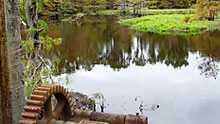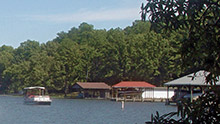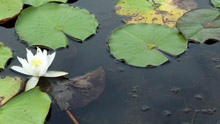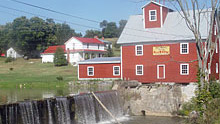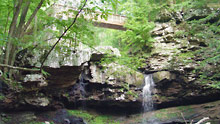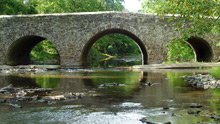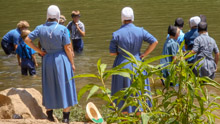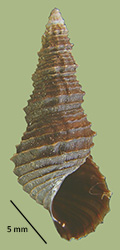> Habitat & Distribution
Populations of P. floridensis floridensis are widespread throughout the northern half of Florida and the Gulf drainages of Georgia (Clench & Turner 1956, Chambers 1980, Thompson 1999) in rivers, springs, and the nearshore regions of lakes with low to moderate current. Hanley & Ultsch (1999) reported individuals on all available substrates, to depths of 1.5 meters, in waters with temperatures of 14 - 26 degrees C and a pH of 7.55 - 8.45. Populations inhabiting streams of central Georgia often bear weakly-sculptured shells, and are here identified as the subspecies P. floridensis induta (Lea 1862).
Pleurocera floridensis was classified as pseudo-rare in our 17-state study area, FWGNA incidence rank I-2p, although our ranking system has not as yet been updated to include the Gulf drainages of Georgia.
> Ecology & Life History
In peninsular Florida, populations of P. floridensis bearing the typical shell morphology lay eggs from February to October, embedding them within sand grain matrices and affixing them to plants and hard objects (Chambers 1980). Although there have been no detailed studies of P. floridensis life history, I imagine that two years are required for maturity, and that several years of iteroparous reproduction can be expected thereafter, as is the case for pleurocerids generally (Dazo 1965). This is life cycle Hi of Dillon (2000: 156 - 162).
Hanley & Ultsch (1999) reported that P. floridensis grazes on algae and other periphyton, as is typical of pleurocerids generally. Grazing by high densities of pleurocerids can have a significant impact on energy flow in streams (Dillon 2000: 86 - 91).
> Taxonomy & Systematics
The taxonomy of the Floridian pleurocerids has been in a state of constant churn since the region first opened to exploration in the mid-nineteenth century. Isaac Lea initiated the conversation with his (1840) Melania boykiniana and catenaria/catenoides, the English publisher Lovell Reeve (1860, 1861) answered with Melania floridensis, M. curvicostata, and several others, and Lea (1862, 1864) countered with inclinans, albanyensis, doolyensis, mutabilis, viennaensis, induta, and many more. Goodrich (1921, 1924, 1942) added vanhyningiana, clenchi, and timidus, Clench & Turner (1956) responded with athearni and dickinsoni, and Mihalcik & Thompson (2002) added seven more species and subspecies to the tower of babble, all beneath further mention.
Genetic divergence at allozyme-encoding loci among populations of all these nominal species has been well studied by Chambers (1978, 1980, 1990) throughout Florida and the Gulf drainages of Georgia. His data suggested that inclinans (Lea 1862), vanhyningiana (Goodrich 1921) and clenchi (Goodrich 1924) are junior synonyms of P. floridensis (Reeve 1860). He considered induta (Lea 1862) a junior synonym of P. curvicostata (Reeve 1861), and did not treat Goodrich's (1942) timidus of the Georgia Atlantic drainages at all.
The population genetic survey of Dillon & Robinson (2011) included control samples of both P. curvicostata (unpubl.) and P. floridensis (bearing the typical shell morphology) from Chambers (1980), timidus from east Georgia, and induta from west Georgia. All three of the last-listed were quite similar genetically, and distinct from curvicostata. We proposed recognizing populations of P. floridensis bearing weak shell sculpture, such as timidus and induta, as a subspecies Pleurocera floridensis timidus (Goodrich 1942).
More recently, as FWGNA surveys have expanded from the Atlantic drainages of eastern Georgia into the Gulf drainages of western Georgia and down to the Florida panhandle, we have become aware of many additional P. floridensis populations bearing shells of reduced sculpture in the historic range of Isaac Lea's Goniobasis induta. Since Lea's (1862) induta (from Gulf drainages) has clear priority over Goodrich's (1942) Goniobasis mutabilis timidus (from Atlantic drainages), we have revised the taxonomy of these populations to Pleurocera floridensis induta (Lea 1862).
Chambers (1982) reported a diploid karyotype of 2N = 36 for four populations of P. floridensis bearing typical shell morphology in Florida, a result that was confirmed by Dillon (1991). Chambers was also able to detect minor karyotypic variation among P. floridensis populations inhabiting three different river systems the Suwannee, the Chipola, and the Choctawhatchee suggesting that the dickinsoni shell morphology (like the induta shell morphology) might have evolved multiple times in these systems independently.
All of these pleurocerid species have travelled through three genera in thirty years. Although predominantly assigned to Goniobasis through most of the 20th century, in the 1980s many workers began placing Goniobasis under the resurrected generic nomen, "Elimia." Both Goniobasis and Elimia were subsumed under Pleurocera by Dillon (2011). See my essay of 23Mar11 from the link below for more.
> Maps and Supplementary Resources
- Pleurocera floridensis distribution in Atlantic drainages (2023)
- Pleurocera distribution in Georgia and the Florida panhandle (2025)
> Essays
- Taxonomic controversy has surrounded the generic nomina Pleurocera, Goniobasis, and Elimia for many years. The best entry into the subject would be my essay of 23Mar11, entitled Goodbye Goniobasis, Farewell Elimia. Links are available from that essay to older resources.
- I reviewed the tortured taxonomic history of P. floridensis in a pair of companion pieces, "Fred Thompson, Steve Chambers, and the Pleurocerids of Florida" (15Feb17) and "Fred Thompson, Elizabeth Mihalcik, and the Pleurocerids of Georgia" (14Mar17).
> References
Chambers, S. M. (1978) An electrophoretically detected sibling species of "Goniobasis floridensis" (Mesogastropoda: Pleuroceridae). Malacologia 17: 157-162.
Chambers, S. M. (1980) Genetic divergence between populatons of Goniobasis (Pleuroceridae) occupling different drainage systems. Malacologia 20: 63 - 81.
Chambers, S. M. (1982) Chromosomal evidence for parallel evolution of shell sculpture pattern in Goniobasis. Evolution 36: 113-120.
Chambers, S. M. (1990) The genus Elimia (= Goniobasis) in Florida (Prosobranchia: Pleuroceridae). Walkerana, 4, 237-70.
Clench, W. J. & R. D. Turner (1956) Freshwater mollusks of Alabama, Georgia, and Florida from the Escambia to the Suwannee River. Bull. Florida State Museum 1: 94 - 239.
Dazo, B. C. (1965) The morpholoogy and natural history of Pleurocera acuta and Goniobasis livescens (Gastropoda: Cerithiacea: Pleuroceridae). Malacologia 3: 1 - 80.
Dillon, R., T. Jr. (1989) Karyotypic evolution in pleurocerid snails: I. Genomic DNA estimated by flow cytometry. Malacologia, 31: 197-203.
Dillon, R., T. Jr. (1991) Karyotypic evolution in pleurocerid snails: II. Pleurocera, Goniobasis and Juga. Malacologia 33: 339 - 344.
Dillon, R. T., Jr. (2000) The Ecology of Freshwater Molluscs. Cambridge, Cambridge University Press. 509 pp.
Dillon, R. T., Jr. (2011) Robust shell phenotype is a local response to stream size in the genus Pleurocera (Rafinesque, 1818). Malacologia 53: 265-277.
Dillon, R. T., Jr. & Robinson, J. D. (2011) The opposite of speciation: Genetic relationships among populations of Pleurocera (Gastropoda: Pleuroceridae) in central Georgia. Am. Malac. Bull. 29: 1 - 10.
Goodrich, C. (1921) Three news species of Pleuroceridae. Occasional papers of the Museum of Zoology University of Michigan 91: 1 5.
Goodrich, C. (1924) Some old pleurocerids and a new one. The Nautilus 38: 43 48.
Goodrich, C. (1942) The Pleuroceridae of the Atlantic coastal plain. Occas. Pprs. Mus. Zool. Univ. Mich., 456, 1-6.
Hanley, R.W. & G.R. Ultsch (1999) Ambient oxygen tension, metabolic rate, and habitat selection in freshwater snails. Archiv fur Hydrobiologie 144:195-214.
Lea, Isaac (1840) Descriptions of new fresh-water and land shells. Proceedings of the American Philosophical Society 1: 284 -289.
Lea, Isaac (1862) Description of a new genus (Goniobasis) of the family Melanidae and eighty-two new species. Proceedings of the Academy of Natural Sciences of Philadelphia 14: 262 - 272
Lea, Isaac (1864) Descriptions of eleven new indigenous species of Melanidae. Proceedings of the Academy of Natural Sciences of Philadelphia 16: 3 5.
Mihalcik, E. R. & F. G. Thompson (2002) A taxonomic revision of the freshwater snails referred to as Elimia curvicostata, and related species. Walkerana 13: 1 - 108.
Reeve, L. A. (1860, 1861). Monograph of the genus Melania. In: Conchologia Iconica, or, illustrations of the shells of molluscous animals, vol. 12. L. Reeve & Co., London.
Thompson, F.G. (1999) An identification manual for the freshwater snails of Florida. Walkerana 10: 1 96.

